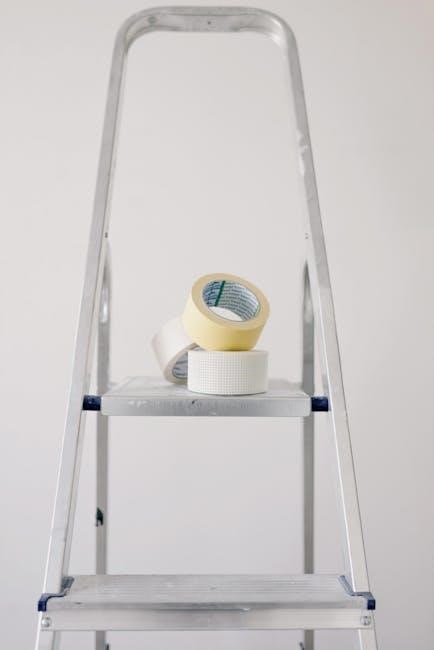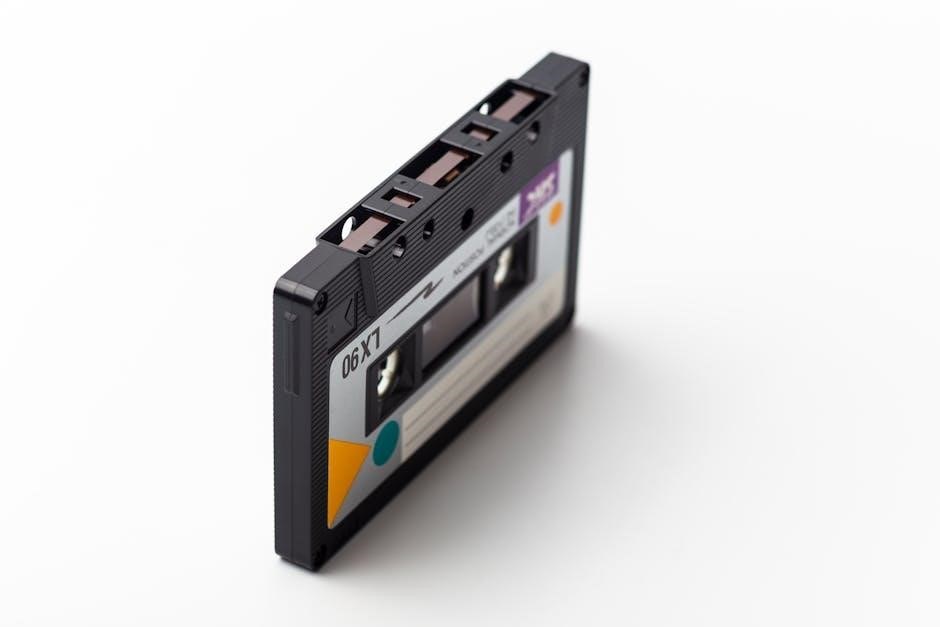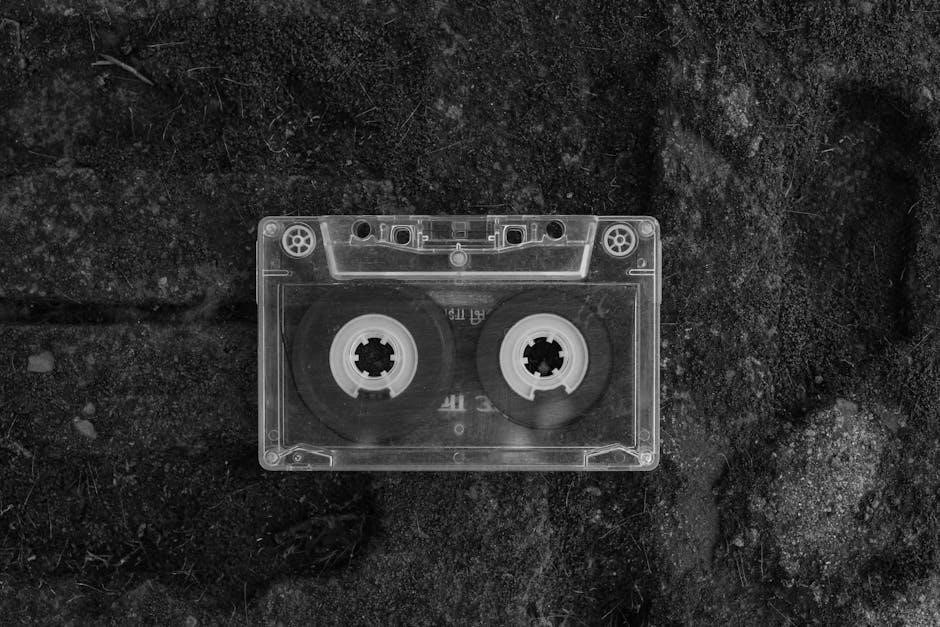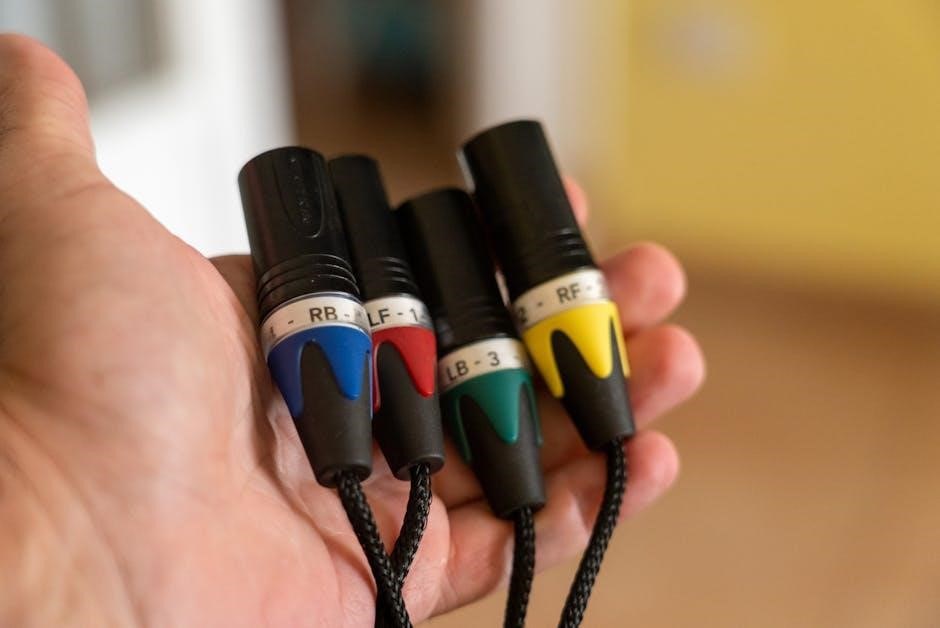KT Tape is a therapeutic tool offering dynamic support for Achilles tendonitis, reducing pain and inflammation through strategic application, aiding athletes in recovery and performance․
Understanding Achilles Tendonitis
Achilles tendonitis is an overuse injury causing inflammation and pain in the Achilles tendon, which connects the calf muscles to the heel bone․ It often results from sudden increases in activity, poor footwear, or uneven running surfaces․ Symptoms include pain at the back of the ankle, stiffness, and swelling․ If untreated, it can progress to degeneration or partial tears․ Athletes, especially runners and cyclists, are prone to this condition due to repetitive stress․ Early intervention is crucial to prevent chronic issues and promote healing․ Proper care, including rest and supportive treatments like KT Tape, can alleviate symptoms and support recovery․ Addressing contributing factors, such as training habits and footwear, is essential for long-term management and prevention of recurrence․
What is KT Tape?
KT Tape is a type of kinesiology tape designed to provide therapeutic support and pain relief for muscles and joints․ It is made from a flexible, breathable material with a gentle adhesive, allowing it to be worn for several days without irritation․ Unlike traditional athletic tape, KT Tape is stretchy, mimicking the elasticity of human skin, and can be applied in various patterns to suit different needs․ It works by lifting the skin to reduce pressure on pain receptors, improving blood flow and lymphatic drainage․ This can help alleviate discomfort, reduce inflammation, and support injured areas during recovery․ KT Tape is widely used by athletes, physical therapists, and individuals seeking non-invasive relief from injuries like Achilles tendonitis․
Benefits of Using KT Tape for Achilles Tendonitis
KT Tape offers numerous benefits for individuals suffering from Achilles tendonitis, providing both pain relief and functional support․ It helps reduce inflammation and alleviates pressure on the tendon, allowing for continued activity with less discomfort․ The tape’s elastic properties promote a full range of motion while offering stability, making it ideal for athletes and active individuals․ Additionally, KT Tape can enhance blood flow and lymphatic drainage, fostering a healthier environment for recovery․ Its non-invasive nature makes it a preferred option for those seeking to avoid medication or surgery․ The tape can be worn for several days, offering consistent support and allowing users to maintain their daily activities without interruption․ Overall, KT Tape is a practical, cost-effective solution for managing Achilles tendonitis symptoms and supporting the healing process․

Preparation for KT Tape Application
Preparation involves cleaning and drying the skin, ensuring proper positioning of the foot in dorsiflexion, and having all materials ready for effective KT Tape application․
Principles of Effective Taping
Effective taping requires clean, dry, hair-free skin for optimal adhesion․ Apply tape with the skin taut to enhance the lifting effect, promoting fluid dynamics․ Use 50-75% stretch to avoid irritation․ Ensure the tape crosses the sore area to maximize pain relief and support․ Proper positioning during application, such as dorsiflexion for Achilles taping, is crucial for functionality․ Post-application, rub the tape to activate adhesion․ Avoid 100% stretch to prevent discomfort․ These principles ensure the tape provides the desired therapeutic benefits, offering both support and pain relief for Achilles tendonitis․
Materials Needed for Application
To apply KT Tape effectively for Achilles tendonitis, you’ll need a few essential materials․ Start with a high-quality KT Tape roll, available in various widths and lengths․ A sharp pair of scissors is necessary for cutting the tape to the desired size․ Clean skin is crucial for proper adhesion, so use alcohol wipes or soap and water to prepare the area․ For those with excessive hair, trimming or shaving the area can improve tape adherence․ Optionally, a hypoallergenic cover roll (like Hypafix) can be used to reinforce the tape ends․ Ensure all materials are within reach before beginning the application process for a smooth and efficient taping experience․
Skin Preparation for KT Tape
Proper skin preparation is essential for effective KT Tape adhesion․ Begin by cleaning the area with alcohol wipes or soap and water to remove dirt, oils, and lotions, which can hinder tape sticking․ Ensure the skin is completely dry, as moisture reduces adhesion․ For individuals with excessive hair, trimming or shaving the area improves tape contact and prevents irritation․ Avoid applying lotions or creams before taping, as they leave residues that weaken the tape’s grip․ Clean, dry, and hair-free skin ensures optimal adhesion and maximizes the tape’s therapeutic benefits․ Proper preparation is key to achieving the best results and extending the wear of the KT Tape․

Step-by-Step Application of KT Tape for Achilles Tendonitis
Apply strips with 50% stretch, starting from the heel, then wrap around the tendon, forming an X pattern for optimal support and pain relief․
Step 1: Anchor Strip Placement
Begin by placing an anchor strip under the heel, ensuring no tension is applied․ Clean and dry the skin thoroughly, trimming excess hair if necessary․ With the foot in a neutral position, press the strip firmly to secure it․ This step provides a stable base for the rest of the tape, ensuring proper adhesion and support․ The anchor strip should be applied without stretching to avoid discomfort․ Smooth the tape gently to remove any air bubbles or wrinkles, ensuring a snug fit․ Proper placement of the anchor strip is crucial for the effectiveness of the entire taping method, as it helps distribute tension evenly across the Achilles tendon․
Step 2: Applying the Main Strip
With the anchor strip in place, move on to applying the main strip․ Begin by dorsiflexing the foot to stretch the Achilles tendon․ Tear the backing paper of the KT Tape strip and apply it with a 50% stretch, aligning it along the length of the tendon․ Ensure the tape crosses directly over the sore area to maximize support and pain relief․ Gently press the tape onto the skin, smoothing it out to remove any air bubbles or wrinkles․ Avoid stretching the tape too tightly, as this could cause discomfort or restrict movement․ The main strip should provide consistent pressure to reduce strain on the tendon while allowing for a full range of motion․ Proper alignment and tension are key to ensuring the tape remains effective throughout activity․
Step 3: Creating the X Pattern
For Step 3, create an X pattern by applying two additional strips of KT Tape, crossing over the main strip at the sorest area of the Achilles tendon․ Tear the backing paper of the first strip and place one end on the outer side of the ankle, just above the main strip․ Stretch the tape with 50% tension and lay it diagonally across the tendon, ensuring it crosses the main strip directly over the pain point․ Repeat this process with the second strip on the inner side of the ankle, forming an X shape․ This pattern provides additional support and helps redistribute stress away from the tendon․ Gently rub the tape to ensure adhesion and smooth out any air bubbles․ The X pattern enhances stability and promotes healing by improving circulation and reducing inflammation in the affected area․
Step 4: Securing the Tape
After applying the X pattern, secure the tape by ensuring all edges are firmly pressed onto the skin․ Pay particular attention to the ends of the strips, as these are prone to peeling․ To reinforce, you can apply small hypafix tabs or additional strips of KT Tape over the edges․ This step is crucial for maintaining the integrity of the tape, especially during movement․ Once the tape is applied, walk around or move your ankle to ensure the tape feels comfortable and secure․ If any edges lift, gently press them down or trim excess tape․ Properly securing the tape ensures it remains effective and lasts longer, providing consistent support to the Achilles tendon throughout daily activities or exercises․ This step is essential for maximizing the benefits of the taping technique․

Step 5: Horseshoe Reinforcement
The horseshoe reinforcement provides additional stability and prevents the tape from peeling off, especially around the heel․ Cut an 8-inch strip of KT Tape and place the center at the back of the heel․ Wrap each end around the ankle bones, bringing them towards the front of the foot․ Apply gentle tension while smoothing the tape to ensure a snug fit․ This technique creates a protective barrier around the Achilles tendon, reducing friction and providing extra support․ Rub the tape firmly to activate the adhesive, ensuring it adheres well to the skin․ This final step enhances the durability of the application, making it more resistant to movement and moisture, thus prolonging the tape’s effectiveness throughout the day or during physical activities․ Properly executed, the horseshoe reinforcement ensures the tape remains secure and functional․

Principles of Effective Taping
Effective taping involves clean skin, proper stretch percentages, and strategic placement to maximize support and pain relief while promoting optimal healing conditions for the Achilles tendon․
Stretch Percentage Guidelines
Proper stretch percentages are crucial for effective KT Tape application; For Achilles tendonitis, a 50-75% stretch is typically recommended, with 50% being standard for most cases․ Overstretching beyond 100% can cause discomfort or skin irritation․ The tape should be applied with the skin in a stretched position to ensure it lifts the skin effectively, enhancing fluid dynamics and pain relief․ Avoid excessive tension to prevent restricted movement or discomfort․ By adhering to these guidelines, KT Tape provides optimal support and promotes healing for the Achilles tendon․
Ensuring Proper Adhesion
Proper adhesion is essential for KT Tape to function effectively․ The skin must be clean, dry, and free of oils or lotions for the tape to stick properly․ Trimming excess hair ensures better contact and prevents irritation․ Applying the tape on clean skin enhances its adhesive properties, while avoiding creases or air bubbles during application ensures a smooth, consistent bond․ Rubbing the tape gently after application activates the adhesive, improving stickiness․ Proper adhesion ensures the tape stays in place during activity, providing continuous support and therapeutic benefits for Achilles tendonitis․ Maintaining these steps maximizes the tape’s effectiveness and longevity․
Positioning for Maximum Support
Proper positioning of KT Tape is critical to maximize support for Achilles tendonitis․ The tape should be applied with the foot in a neutral or slightly dorsiflexed position to ensure it aligns with the natural movement of the tendon․ Applying the tape while the skin is taut helps it adhere smoothly and provides consistent pressure․ The tape strips should cross directly over the sore area to target the inflamed tendon effectively․ Avoid stretching the tape too tightly, as this can cause discomfort or restrict movement․ Instead, use a moderate stretch (50-75%) to provide gentle, dynamic support․ Proper positioning ensures the tape reduces strain on the Achilles tendon during activity, promoting healing and pain relief․ This strategic placement enhances the tape’s therapeutic benefits and overall effectiveness․

Wear and Tear of KT Tape
KT Tape typically lasts 3-5 days, depending on activity level and environmental factors․ Moisture, sweat, and friction can reduce adhesion, while proper care extends durability․
Wait, no, the user’s latest query says to put the response within
How Long Can KT Tape Stay On?
KT Tape can typically stay on for 3 to 5 days, depending on factors such as activity level, sweat, and skin preparation․ Properly applied tape adheres well, even when showering, though it’s best to pat dry rather than rub․ Moisture and friction can reduce its longevity․ For optimal wear, ensure the skin is clean, dry, and free of oils or lotions before application․ Avoiding excessive exposure to water or humidity can help extend its durability․ If edges begin to peel or adhesion weakens, it’s time to reapply․ With care, KT Tape can provide continuous support for several days, making it a convenient solution for managing Achilles tendonitis during daily activities․
Maintenance Tips for Longer Durability
To extend the wear of KT Tape, ensure proper skin preparation by washing with soap and water, avoiding lotions or oils․ Gently pat the tape dry after showers; rubbing can weaken adhesion․ Trim excess tape to prevent fraying, and avoid tight clothing that may cause friction․ For added durability, apply reinforcement strips using hypoallergenic cover roll tape on edges prone to peeling․ Regularly inspect the tape for lifting edges and smooth them down․ These steps enhance adhesion and ensure the tape remains effective for its intended duration, providing consistent support for Achilles tendonitis management․
When to Reapply KT Tape

Kinesiology tape typically lasts 3-5 days, but reapplication is necessary if the tape loosens, frays, or loses adhesion․ Signs include edges peeling up, reduced support, or discomfort․ After swimming or excessive sweating, inspect the tape; if compromised, replace it․ If the Achilles tendonitis symptoms persist or worsen, reassess the taping technique or consult a professional․ Reapply clean, dry tape as needed to maintain therapeutic benefits and support․ Proper reapplication ensures continuous relief and protection for the tendon, promoting healing and preventing further strain or injury․ Regular monitoring and timely replacement are key to maximizing the effectiveness of KT Tape for Achilles tendonitis management․

Additional Considerations
Combine KT Tape with therapies like ice and rest for optimal relief․ Consult a professional if pain persists or worsens, ensuring comprehensive Achilles tendonitis management․
Complementary Treatments for Achilles Tendonitis
Alongside KT Tape, incorporating ice therapy can reduce inflammation and relieve pain․ Rest and anti-inflammatory medications are also beneficial․ Physical therapy, including stretching and strengthening exercises, enhances recovery․ Orthotics may correct biomechanical issues, while massage promotes blood flow and tendon healing․ A comprehensive approach combining these treatments supports optimal healing and prevents recurrence of Achilles tendonitis․
Risks and Contraindications
While generally safe, KT Tape may cause skin irritation or allergic reactions in some individuals․ Avoid applying tape on open wounds, swollen areas, or infected skin․ Overstretching the tape can lead to discomfort or restricted movement․ For severe Achilles tendonitis, consult a healthcare professional before taping․ Those with circulatory issues or sensitive skin should exercise caution․ Discontinue use if pain worsens or if skin reactions occur, seeking medical advice promptly․ Proper application and adherence to guidelines minimize risks, ensuring safe and effective use of KT Tape for Achilles tendonitis management․
When to Seek Medical Advice
Consult a healthcare professional if Achilles tendonitis symptoms persist despite KT Tape use․ Seek immediate medical attention for severe pain, swelling, or inability to bear weight․ If pain worsens with activity or is accompanied by redness or warmth, underlying conditions like tendon ruptures may exist․ Ignore persistent symptoms, as early intervention prevents long-term damage․ A doctor can provide a proper diagnosis and recommend comprehensive treatment plans, ensuring optimal recovery and preventing further complications․ Timely medical advice is crucial for effective management of Achilles tendonitis and avoiding chronic issues․ KT Tape is a supportive tool but not a substitute for professional care in severe cases․ Addressing symptoms promptly ensures the best outcomes for tendon health and functionality․
KT Tape is a valuable tool for managing Achilles tendonitis, offering support and pain relief․ For severe or persistent symptoms, consult a healthcare professional to ensure proper treatment and recovery․

Final Tips for Effective Use of KT Tape
- Always clean and dry the skin before application to ensure proper adhesion․
- Trim excess hair to prevent irritation and improve tape durability․
- Avoid stretching the tape beyond 75% to minimize skin irritation․
- Apply the tape with the skin in a stretched position for optimal support․
- Use a horseshoe reinforcement strip to secure the anchor and prevent peeling․
- Reapply the tape every 3-5 days or after excessive sweating or swimming․
- Combine KT Tape with complementary treatments like ice, rest, and stretching for enhanced recovery․
- Consult a healthcare professional if pain persists or worsens despite taping․
By following these guidelines, KT Tape can provide effective support and pain relief for Achilles tendonitis, helping you return to your activities confidently․
Importance of Combining with Other Therapies

While KT Tape provides excellent support and pain relief for Achilles tendonitis, it is most effective when used alongside other therapeutic approaches․ Combining taping with treatments like ice therapy, rest, and anti-inflammatory medications can enhance recovery and reduce inflammation․ Additionally, incorporating stretching exercises, physical therapy, and strength training helps improve tendon flexibility and strength, addressing the root cause of the condition․ This multi-faceted approach ensures a more comprehensive healing process, preventing further injury and promoting long-term tendon health․ By integrating KT Tape into a holistic treatment plan, individuals can achieve faster and more sustainable relief from Achilles tendonitis symptoms․

